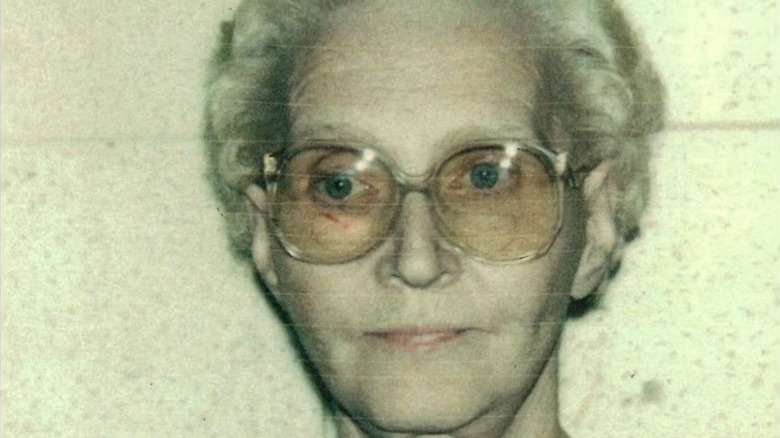What Happened To Dorothea Puente's Victim Vera Faye Martin?
When you imagine the worst roommate ever, you're probably picturing a loud, obnoxious 20-something who blasts loud music all hours of the night and leaves dirty dishes everywhere. It is unlikely that your mind would naturally gravitate toward a matronly granny in oversized frames known for her baking and home healthcare. But that is exactly what we find in Netflix's shocking "Worst Roommate Ever" docuseries, which takes us on an unexpected journey through the criminal mind, a kind of haunted house tour where cohabiting is revealed to be incredibly dangerous, and sometimes even deadly (via Netflix).
The start of the series introduces viewers to Dorothea Helen Puente (pictured above), a ruthless serial killer who hides her true identity behind a grandma-like persona (per ScreenRant). But don't let the glasses and baked goods fool you. Puente is a cold-blooded killer secretly swindling her victims out of their social security checks and burying them in the graves she calls her garden. Sadly, Vera Martin Faye was one of at least nine victims to fall prey to this psychopath's scheme, and her story deserves to be heard, even if the message reaches long after her death.
Vera Faye Martin was on a road to recovery
Little is known about the life of Vera Faye Martin, although her brutal death has certainly received a great deal of media attention and scrutiny. In 1996, The New York Times reported that Martin had come to be known as one of "The Shadow People", a term used to describe individuals who had already been victims of social marginalization prior to meeting Puente.
As a coverup for more sinister deeds, Dorothea Puente ran a boarding house for people such as this, those who were, in one way or another, on a road to recovery. Her boarders, often elderly, were also frail. In many cases, they were either vulnerable to or already experiencing homelessness (via Los Angeles Times). Some were additionally battling other illnesses related to old age, mental health, or addiction. However, there is no indication as to whether Martin personally fit that description. What's clear is that boarders like Martin had little to no contact with friends or family, and were effectively trying to pull themselves up by the bootstraps and into a better life on their own.
She wound up in a literal house of horrors
On the surface, the sprawling bungalow on F Street in Sacramento was a safe haven for the weary (per ScreenRant). It certainly seemed that way to the St. Paul Senior Center homeless program, Volunteers of America, and multiple other outreach agencies that continuously referred elderly and homeless individuals to board there (via New York Post). One social worker, a woman named Peggy Nickerson, completely fell for the ruse. According to the Los Angeles Times, Nickerson had believed Puente was "friendly" and "willing to help in any way she could."
The boarding house offered temporary refuge along with hot meals, and of course, the notorious garden which authorities would later find was brimming with the bodies of Dorothea Puente's victims. Tragically, Martin was one of many boarders labeled a "wanderer" or drifter." Eventually, her body would be unearthed with others in the garden. According to ScreenRant, when Vera Faye Martin's body was found, the watch on her wrist was still ticking.
Countless warning signs were ignored leading up to Martin's death
Grandmotherly-looking or not, Dorothea Puente had plenty of priors in her criminal history. From a legal standpoint, she should not have been running a boarding house at all. According to ScreenRant, the notorious killer who wound up taking Vera Faye Martin's life had already spent three years in prison for related crimes — notably robbing and drugging elderly people she was charged with caring for in her past. The Los Angeles Times reports that during that time, there were even allegations of possible homicide, which authorities refused to comment on further.
She got by running her boarding house under a loophole, since it was not technically deemed a "care facility." As the case began unfolding and Puente's façade faded, Kathleen Lammers, Executive Director of the California Law Center on Longterm Care, told The New York Times, "These entities fall through the cracks." She then pointed out that the case of Vera Martin and countless other victims are examples of the need for stricter laws pertaining to elder abuse. Puente's shadowy past notwithstanding, it's important to note that authorities dropped by this house of horrors not once, not twice, but fifteen times, and still remained clueless to the fact that there were bodies buried in the garden, per the Los Angeles Times.
Vera Faye Martin was possibly buried alive
Vera Faye Martin was revealed to be one of many victims to be ruthlessly murdered so her landlord could continue fraudulently cashing her government checks (via History). But, according to ScreenRant, there was something very different about this murder. Indeed, it was considered, perhaps the most gruesome. While the vast majority of Puente's victims are believed to have been poisoned, suffocated, or strangled, Martin is the only identified victim who was possibly buried alive.
At 64 years of age, Martin seemed to have mysteriously vanished, never to be seen again until police pulled her body from the ground. With her watch still ticking around her wrist, the crime scene displayed something haunting. Scratch marks circled the site of her makeshift grave, a telling sign that she was possibly still alive when she was thrust into the ground. Whether this was a mishap or evidence of escalating violence against her victims is one mystery that will never be solved.
Dorothea Helen Puente was never convicted of killing Vera Faye Martin
According to ScreenRant, even though authorities uncovered the remains of several victims in the garden Puente turned into a graveyard, she was only convicted of killing three. Those victims were Leona Carpenter, Benjamin Miller, and Benjamin Fink. While the heartless landlord died serving back-to-back life sentences (via All That's Interesting), she was never officially convicted of killing Vera Faye Martin. This is despite the fact that over 130 witnesses testified in court against the calculating landlord.
While very little is known about the life of Vera Martin beyond the grim details of her death, there's a great deal to ponder in her absence. At the time of the events, this disquieting case sparked a necessary conversation about elder abuse that ultimately led to stricter legislation (per Los Angeles Times). However, Puente took advantage of another marginalized community that lacks legal protections even to this very day — the homeless community, whose members are all-too-often targeted by criminals, villains, and gangs.





